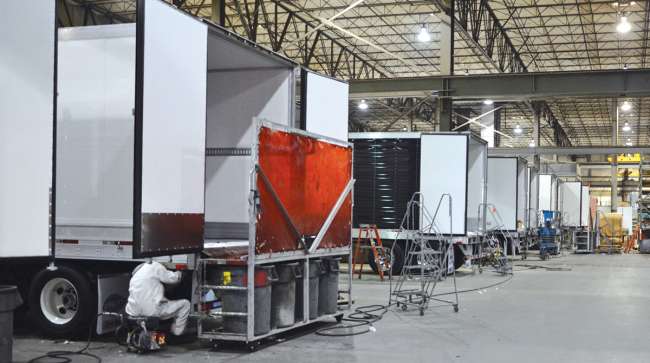Senior Reporter
ACT Forecasts Imminent Slowdown in Class 8, Trailer Production

[Stay on top of transportation news: Get TTNews in your inbox.]
For those still wondering about the state of the commercial vehicle market in the United States, ACT Research during a webinar Sept. 11 delivered a forecast that conditions continue to deteriorate and that pullback in build rates for heavy-duty trucks and trailers is “imminent.”
ACT President Kenny Vieth said there are simply too many trucks chasing too little freight, and many of the trucks now are very young and will not be replaced soon.

Vieth
Orders are continuing to plunge and the Class 8 backlog is dropping by about 15,000 to 20,000 units a month, he said, and will be 155,000 units in August. The backlog in October was 302,000 units — which makes “for a painful downturn.”
In related news, three truck makers recently announced either outright production cuts, in the case of Navistar Inc., or down weeks in the case of Mack Trucks and Volvo Trucks North America. Together they accounted for 33% of U.S. Class 8 retail sales in August, according to WardsAuto.com.
RELATED: Mack Plans Temporary Layoffs at Pennsylvania Plant
As for trailer makers, they surged into 2019 and “are kind of stumbling out into 2020,” said Frank Maly, ACT’s director of commercial vehicle transportation analysis and research.
Trailer makers have opened their order boards for 2020, but there hasn’t been a lot of fleet interest. “Not that long ago, fleets were really clamoring for spots.”
For-hire freight demand fell into a mild recession in the first half of 2019, said ACT Vice President Tim Denoyer. Loads fell in each key ground mode: truckload, less-than-truckload, intermodal and carload rail.

Denoyer
“Almost every key measure of the freight market dropped pretty materially from late 2018 until recently [when inventory builds occurred temporarily ahead of more costly tariffs],” he said.
A related factor in the softening of the for-hire freight market is the double-digit growth in Class 8 tractors at private fleets, Denoyer said. “Since they are just over half of the overall tractor market, at this point, that is pulling a lot of freight out of the for-hire market.”
ACT believes private fleets were the first ones to order when capacity tightened really sharply in 2017 following the costliest hurricane season in U.S. history. Tropical Storm Emily and Hurricane Irma were among the major storms that year, according to the National Hurricane Center.
Now with that added capacity, and spot rates being down about 20% from earlier highs, those private fleet companies are “quite disincentivized” from ordering new equipment, Denoyer said. On the other hand, that suggests freight will start migrating back into the spot market sometime next year, “which is a critical factor needed to get the next up-cycle going.”
A steady, bright spot is the health of the consumer — in terms of real disposable personal income, up about 3% year-over-year, and a personal savings rate of just under 8%. Consumer spending drives the majority of truckload freight, he said.
But manufacturing and housing are very soft. Lower interest rates might provide some support for housing, “but we are struggling to see how manufacturing is going to recover with the elevated levels of uncertainty out there,” Denoyer said.
Looking ahead, “We think we will be able to avoid an economywide recession,” said Sam Kahan, ACT’s economic forecaster. “The imposition of tariffs and their composition is the major uncertain factor affecting the direction of the U.S. economy.”
Kahan said the Federal Reserve will carry on in a measured and moderate manner and assume an easing posture on interest rates in the near term, dropping, possibly, to 1.5%. Interest rates lenders charge businesses and consumers build on the rate the Fed sets for intra-bank loans.


